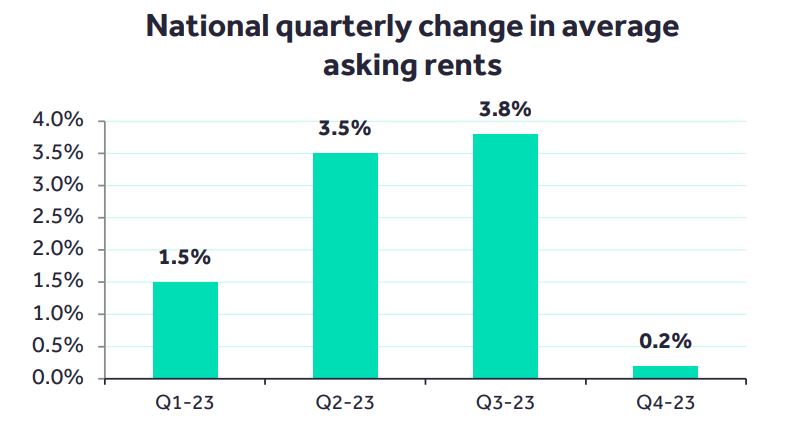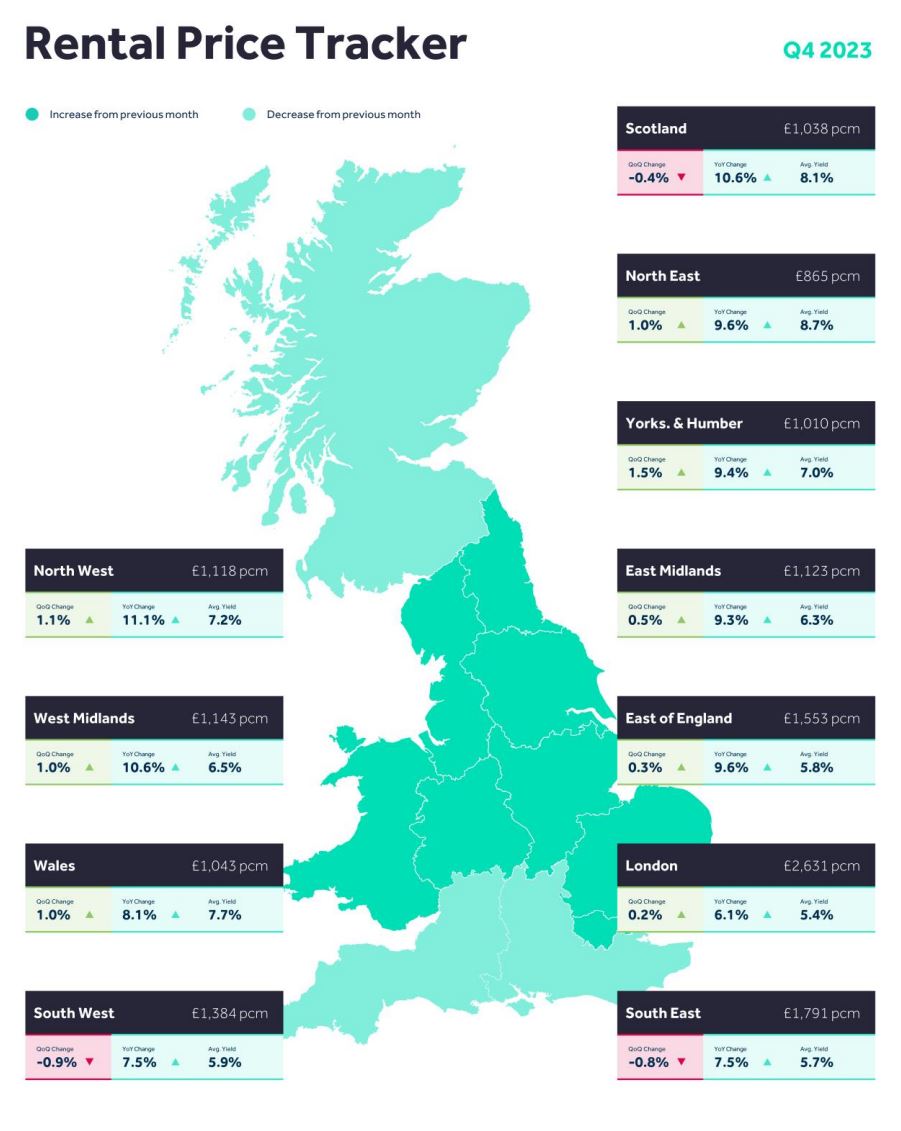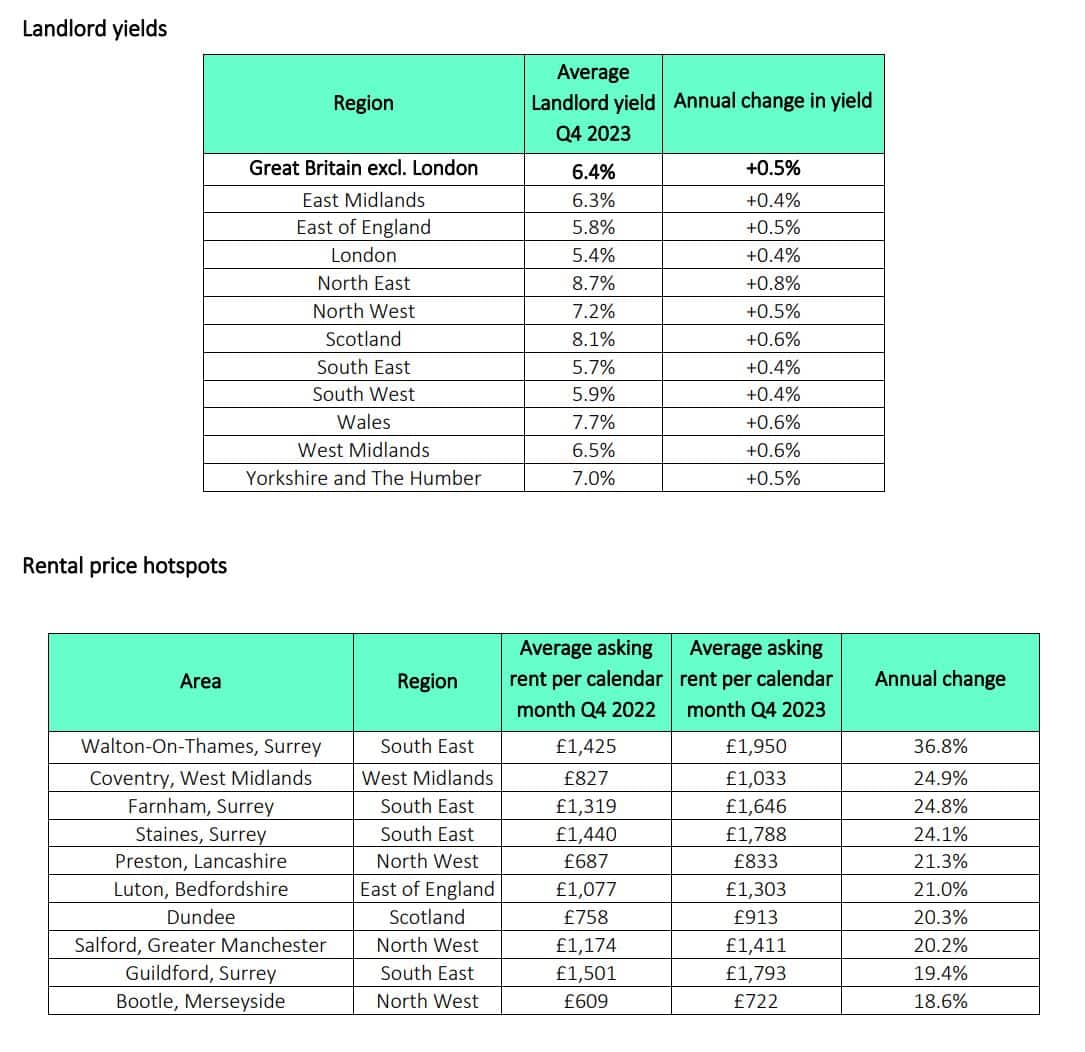The largest quarterly dataset of UK rental activity. Q4 report (October – December 2023)
Record rents but tenant affordability ceiling leads to lowest growth since 2019
Average advertised rents outside of London rise to a new record of £1,280 per calendar month (pcm).
However, this quarter’s jump of 0.2% is the smallest since 2019 as the pace of rent growth slows:
o Advertised rents are now 9.2% higher than last year – the lowest annual growth in rents since 2021
o London rents also hit a new record of £2,631 per calendar month, rising by 0.2% this quarter
o Rightmove predicts average rents will rise by 5% outside of London in 2024 and 3% in London
The trend of supply improving and tenant demand easing continues at the start of 2024:
o The number of tenants sending enquiries to letting agents to move is 13% lower than the same period last year
o The number of new rental properties coming onto the market is 7% higher than last year
o The average number of enquiries agents are receiving for every available rental property is currently 11, which whilst still much higher than the four at this time of year in 2019, is down from 14 last year
There are also signs that more tenants are hitting an affordability ceiling, with nearly a quarter (23%) of rental properties needing a reduction in advertised rent, compared with 16% at this time last year
Average landlord yields are at 6.4% across Great Britain on average, the highest since Rightmove records began, and up from 5.9% last year
Overview
The average advertised rent for new properties coming onto on the rental market hits another new record outside of London of £1,280 per calendar month (pcm). Despite a 16th consecutive record in newly advertised rental prices, this quarter’s rise of just two pounds (+0.2%) is the smallest since at this time in 2019 before the pandemic.
Advertised rents outside of London are now 9.2% higher than last year, which whilst still a significant annual increase, is the lowest rents have been compared to a year ago since 2021. It’s the same story in the capital, with rents in London reaching a new record of £2,631. However, this is just four pounds (0.2%) higher than the previous quarter, as the yearly increase of rents in London halves from 12% last quarter, to 6% now. This is the first time London rent rises have been in single digits versus a year ago since 2021.
The early signs indicate that the annual pace of rent growth will slow further in 2024, and Rightmove predicts rents to be 5% higher outside of London by the end of 2024, and 3% in London. One of the main contributors to the slowing of rent rises, and the anticipation of a further slowdown in 2024, is an improvement in the balance of supply and demand in the rental market.
The trend of supply improving and tenant demand easing has continued at the start of 2024. The number of tenants sending enquiries to letting agents to move is 13% lower than the same period last year. At the same time, the number of new rental properties coming onto the market is 7% higher than last year.
To put this into perspective, the average number of enquiries agents are receiving for every available
rental property is currently 11, which while still nearly triple the four at this time in 2019, is down from 14
last year. The market is still very busy compared to pre-pandemic levels. However, these early signs suggest a better
experience for many tenants trying to secure a rental property in 2024. There are also signs that more tenants are beginning to hit an affordability ceiling, further contributing to slowing rent rises.
Nearly a quarter (23%) of rental properties now see a reduction in advertised rent by the landlord, markedly up from the 16% at this time last year, suggesting the initial advertised rental price in some areas is increasingly out of reach for some tenants.
Landlord yields are currently at the highest level since Rightmove records began. The average yield across Great Britain is now 6.4%, up from 5.9% last year. Rightmove’s Director of Property Science Tim Bannister says: “The trend of rent growth gradually slowing continues, with an improvement in the supply and demand of rental properties having a big contribution to that. We can’t keep seeing double digit rent rises every year as tenant affordability simply cannot keep up, and 2024 is the year we think there will be a much smaller increase in advertised rents of 5% outside of London, and 3% in the capital.”
Christian Balshen, Rightmove’s lettings expert said: “We hope this trend of a better balance between supply and demand continues this year, but the reality is letting agents are still extremely busy compared to what we used to consider ‘normal’.
“We’re seeing more evidence that many tenants are reaching the point where they can’t afford to pay any more in rent, which is leading to reductions in advertised rental prices and means some properties are staying on the market for longer. The average time to find a tenant has ticked up from 19 days at this time last year, to 22 days now. To reduce the risk of void periods, landlords will need to work closely with a local letting agent this year, who will have access to the latest market insights to back up their years of expertise.” Agents’ Views
Hayley Brinn, Director at The Total Letting Service said: “The market is still really busy, and the high number of applicants per property is being exacerbated by some landlords leaving the market. Prices appear to be levelling out now as more choice becomes available, with tenants becoming more price sensitive, or just reaching the maximum of what they can afford to pay. The prices of larger properties in particular are slowing down, unless the landlord accepts an offer. Some tenants are reluctant to move unless they have no choice, due to the risk of being charged higher rents elsewhere, while other tenants who may want to move are stuck due to their current rent being below market value, and the price gap to move to a larger house is out of their reach. Rent prices slowing this year would benefit these tenants wanting to move.”
Peter Lee, Director at Redbrik in Sheffield, said: “Several factors have contributed to the increased demand for rental properties, including rising mortgage rates, making purchasing less affordable. Additionally, the post-COVID landscape has allowed for greater flexibility in remote working, prompting a notable influx of young professionals relocating from London to more cost-effective cities in the North. Consequently, rental prices have grown substantially, and the smaller homes market has experienced the most significant and sustained increase. Whilst the larger homes market has also experienced an upward trend, the rate of increase has been more modest, resulting in a compression of overall price differences between smaller and larger properties. It’s important that landlords are up to date on the latest market trends and activity in their area so that they can price accurately, and secure the best tenant for the long term, and minimise void periods.”
The Rightmove Rental Trends Tracker methodology was updated as of Q3 2020 and all historic figures have beenrestated. The new methodology includes the latest mix adjustment figures.
The dataset is compiled from the asking rents of properties coming onto the market on Rightmove.co.uk. Rather than being a survey of opinions it is produced from factual data of actual asking prices of rental properties currently on the market. Rightmove’s Rental Trends Tracker measures prices at the very beginning of the rental process.
Quarterly data: Rightmove measured 547,291 asking rents. The properties were advertised on Rightmove.co.uk
by agents from 1st October – 31st December 2023. All short lets have been removed. All rents throughout are per
calendar month.
Competition is calculated based on the number of people enquiring about each available property.
Source: Rightmove






